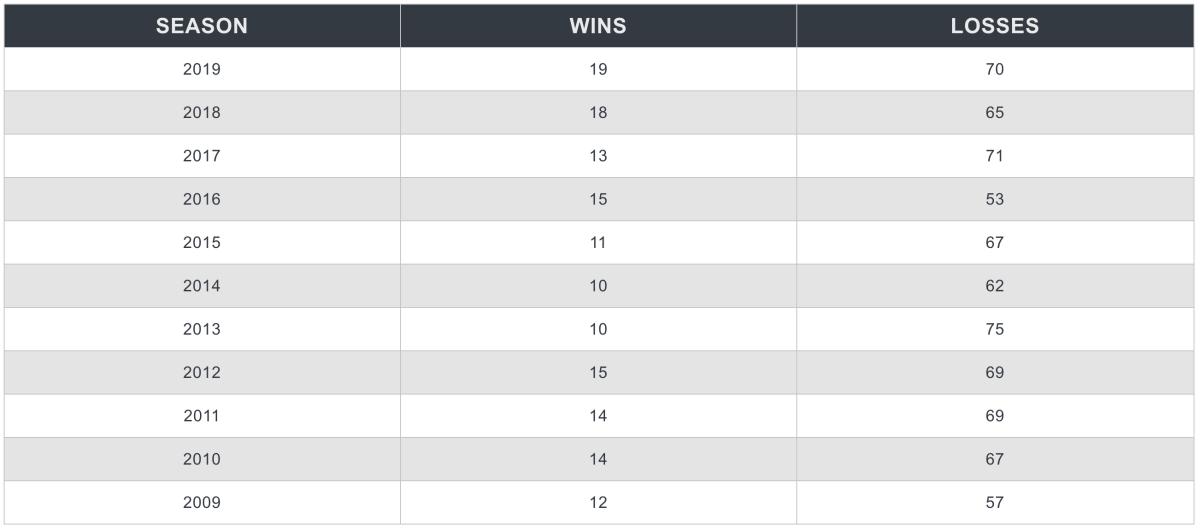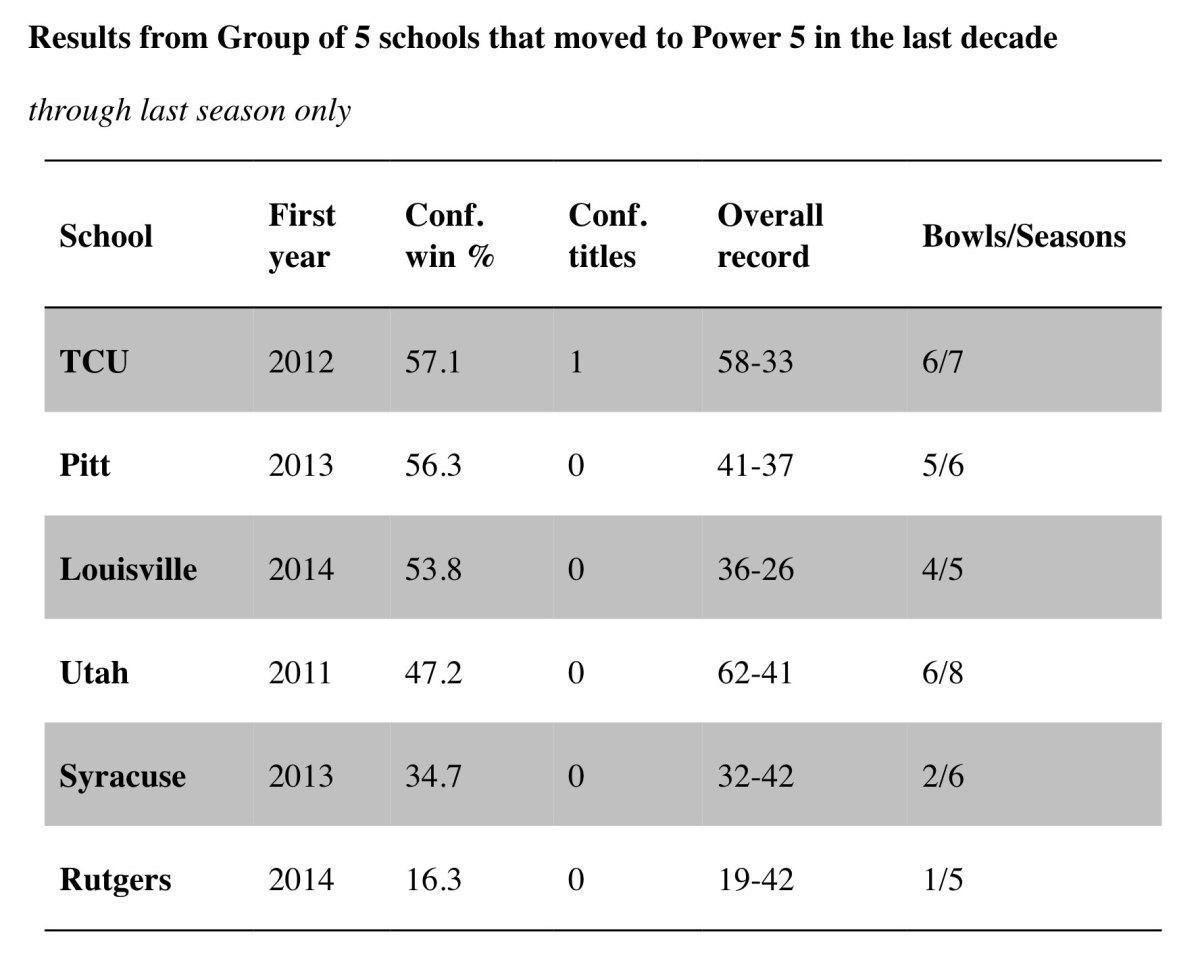As Group of Five Continues to Rack Up Power 5 Wins, Will CFP Opportunity Ever Arise?

Brian Harsin was the offensive coordinator at Boise State when the Broncos famously beat Oklahoma in the 2006 Fiesta Bowl. So don’t blame him if he still uses a 13-year-old game as proof that the Davids of the world can take down the Goliaths. “You go back to Oklahoma-Boise State,” he says. “They said, ‘You got no shot!’ Our guys were dumb enough to believe they did.”
Years later, now as head coach of that same Boise program, Harsin has plenty more examples to prove his point. Since that game, the little guys have knocked off the big boys more than 150 times. Also since that game: not much has really changed for the Davids of the world. Harsin’s No. 16 Broncos remain one of six undefeated teams in the lower-tier of the Football Bowl Subdivision, and they have no real shot of winning a national championship. College football remains the only postseason in American sports, college or pro, where such a miserable fate is possible. “I don’t know if we think like that, but there is a reality in there,” Harsin admits. “One of us actually making the playoff today is very slim. It’s not happening because of the perception.”
Through its first month, the 2019 football season has delivered the usual excitement. Top-10 showdowns like Texas-LSU and Georgia-Notre Dame have shaped the postseason picture, and drama-filled meetings like Arizona State-Michigan State and Iowa-Iowa State have immortalized heroes. But some of the most eye-peeling results have come from a subsection of the college football world, the one you know as the Group of Five. Through four weeks, that tier of the sport has 19 wins over its aristocratic other half, the Power 5. The 19 victories are the most for the Group of Five through the first four weeks of a season in at least a decade, according to research from STATS Perform. Just this past weekend, G5 teams won three games over P5 schools. SMU, San Jose State and Appalachian State all grabbed wins as 13.5-, 20- and 8.5-point Vegas underdogs. Of the 19 overall G5 victories, the Mountain West, of which Boise belongs, has eight, and the American Athletic Conference, of which Goliath-slaying UCF belongs, have four. Some of the country’s most historic programs found themselves beneath the boot of their little brothers, including Florida State, Tennessee (twice), North Carolina, UCLA, Ole Miss and USC.
Group of Five’s Record vs. Power 5 Through Four Weeks of Each Season

While the losers of these games continue their pursuit of a national championship—albeit, most of them have been eliminated with losses—the winners, even before the season began, know they’ll never have that chance. “I think you’re being real there,” says Troy Calhoun, the longtime coach at Air Force. “Let’s be hypothetical: If UCF won every game by three touchdowns, they’re still not getting in. The system isn’t set up like that. It’s the only sport at any level like that. Only way for it to change is to go to an eight-team playoff.”
This is a tired argument in a sport full of tired arguments—Will the playoff expand?—but the Group of Five’s early-season success pushes the discussion back to the forefront. The playoff will expand. Even those at the highest level of the sport will tell you that it’s not a matter of if but a matter of when. The swell for change grows with each passing year that a major conference champion is left out. There are four spots; there are five major conferences. Do the math. “My personal opinion: playoff expansion is going to happen,” says Josh Heupel, whose UCF team had won 27 consecutive regular season games—three against Power 5 foes during that stretch—before a loss at Pitt on Sept. 21. “It’s a matter of how it happens, whether it’s teams like us or the fact the Big Ten champ hasn’t been in for three straight years.”
The Pac-12 and Big Ten champion have missed the playoffs in each of the last two years. The Big 12 champion was left out of the inaugural playoff in 2014 and the 2016 edition. Garnering less attention are three undefeated teams that also have missed the playoff: UCF in 2017 and 2018, and Western Michigan in 2016. Did those three teams deserve a shot at competing for a national title? Some would say no, others yes. “An undefeated team—if you’re undefeated, anybody in Division I football—you should have a chance to play for it all,” says Harsin. “They’re going to say we can’t compete. Sure not in facilities but on the field, we can.”
We’ve seen smaller programs succeed in other sports. For instance, Villanova has won two of the last four NCAA men’s basketball tournaments, and since 2004, four non-Power 5 programs have won College World Series titles. Football is different, sure. Quality depth is a critical element that some smaller programs lack, a byproduct of a recruiting disadvantage. Group of Five programs have signed roughly 240 recruiting classes over the last four years. None of those have finished in the top 30. The lower-tier of college football fights a perception problem just as much as they fight a financial problem. “I have my Olympic sport coaches tell me they have kids in recruiting—volleyball and women’s soccer—who want to go to a Power 5 school,” says Danny White, in his fifth year as UCF’s athletic director. “What does that even mean? It’s a term that’s become so mainstream as if it is a differentiator.”
The financial gap, though, cannot be overlooked. The richest Group of Five school is UConn, ranking 52nd with a budget of $79.3M a year. For some perspective, the lowest-ranked Power 5 school is Washington State, which is one spot behind UConn at 53rd. More than half of the Power 5 schools have a budget of at least $100 million. “The only gap between the Power 5 and Group of Five is money,” Harsin says. “As for players, the money piece… you use for facilities. It does affect players and what you’re able to do, but we do all those things. It might not be as easy to do it financially. Got to go out and raise it.”
The money issue is rooted in TV contracts. The AAC has the richest television deal among Group of Five teams, distributing slightly less than $7 million to each school, nearly $20 million less than the lowest P5 conference’s TV distribution rate. The Mountain West is 30–50 days away from completing its new TV deal, says Mountain West commissioner Craig Thompson. Could the Mountain West overtake the AAC as the Group of Five’s richest conference? Potentially. The AAC touts itself as the sixth school in a “Power 6.” The conference has, after all, earned the CFP’s G5 bowl spot in three of the last four years.
“If it’s a power anything, it’s a Power 6,” White says. “Our conference was better than one or two of the so-called Power 5 last year.” Meanwhile, Thompson has numbers to show that his league is just as strong. Through the first two weeks of the season, for example, the Mountain West led all 10 FBS conferences with six victories over Power 5 teams. But this isn’t a Group of Five vs. Group of Five battle. It is a Group of Five vs. Power 5 war. “I hate the labeling Power 5 and Group of Five,” Thompson says. “The other thing we’ve always heard consistently… ‘If TCU and Utah played in a Power 5 they wouldn’t have success.’ TCU has had very consistent success. Everything is relative when you have those finances and rise to that level.”
Six schools transitioned from the Group of Five to the Power 5 since 2011. The Horned Frogs, which made the switch from the Mountain West to Big 12, have the best conference win percentage of any of them. TCU has won 57.1% of its Big 12 games, claimed a conference championship and went to six bowl games in seven years. Two more programs that made the move have won at least 50% of their league games, including Big East-to-ACC movers Pitt and Louisville. Add in Utah and those four teams have combined for 21 bowl trips in 26 chances as new Power 5 clubs. Those numbers illustrate, White and Thompson say, that the gap is more perception than reality.

They have plenty of supporters, too. Even a sitting CFP committee member believes the playoff should expand to include the best G5 squad. “I’ve often thought that the best situation would be an eight-team playoff,” says former Virginia Tech coach Frank Beamer, on his last year of a three-year appointment to the committee. “I say that from the standpoint of taking the conference champions—they’re automatically in—one from the Group of Five and a couple at-large, but I don’t think it’s going to change any time soon.”
The Pac-12 has made the fewest appearances, by playoff games, of any Power 5 conference. Commissioner Larry Scott is “satisfied” with the CFP, but is open to discussing expansion. “I’m part of those conversations, which are very early,” he said. “I don’t expect any conclusion any time soon. We’ve got agreements that go to 2026.” The agreement he’s referencing is a $17.2 billion contract between ESPN and the CFP. The deal has eight more years left on it. That’s a long time—too long for some. “I think we should expand the playoff and have it be a real postseason,” White says, reinforcing a feeling he’s made public in the past. “We’ve always been in a kind of beauty pageant mode in college football. The four-team playoff is way better than anything we’ve had before. It’s progress, but I don’t understand why we can’t have a postseason like any other sport in America, college or pro.”
One of the most outspoken high-profile figures against expansion is a man who presides over a conference that has qualified a member school for the playoff every year of its existence. SEC commissioner Greg Sankey suggests that his league’s conference schedule is a difference-maker. “I’ve been quoted on those issues before and that fills my Twitter feed with perspectives,” he said, smiling during an interview last month. “It’s a long season. Scheduling has an impact. We’ve learned that in other sports. We have a uniquely rigorous conference schedule. People have to continue to adjust to that model.”
Meanwhile, the Davids of the world, despite their monetary disadvantages, will continue to challenge the hierarchy of college football. “This whole Power 5 and Group of Five thing, it’s always bothered me,” Harsin says. “You got Division I football players on both sides of the ball. They’re going to play and they don’t care about any of that.”
